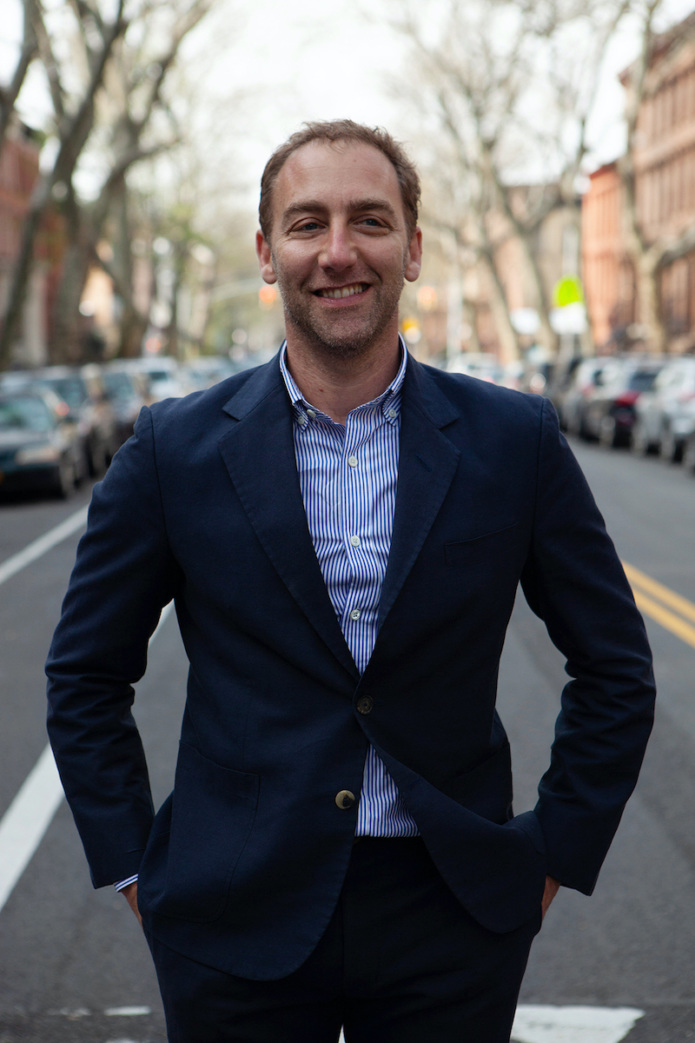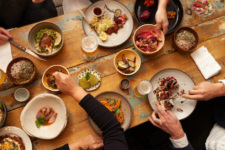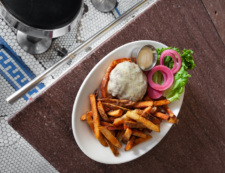
Restaurants’ New Normal? It’s How Andrew Tarlow Built His Brooklyn Empire
Creation stories surround Andrew Tarlow and his restaurants, but none trumps the cassoulet.
Caroline Fidanza, the opening chef at Diner, Tarlow’s first restaurant, chose that hearty staple of southwestern France as a New Year’s Eve treat for the ragtag group that was bringing Diner to life back in 1998. It was Tarlow’s introduction to the dish, one he would recount in his memoir-slash-cookbook, Dinner At the Long Table. And it set a template for the cooking he would bring to all his restaurants: rustic, soulful, and French-leaning, with an attentiveness to fresh ingredients and clean, tight cooking that echoed the simple-presenting bistro cooking of places like, say, Chez Panisse.
Why this matters is that Tarlow, at the time a bartender and struggling artist, would inject this aesthetic into an unlikely place: unreconstructed stretches of south Brooklyn that would, within a few years become Williamsburg with a capital-W and, soon enough, porkpie hats and ironic air quotes. Not only would Diner would become a template for a Brooklyn way of eating, but Tarlow would build a new sort of restaurant empire, one not based on white tablecloths or nigiri dotted with jalapeños, but on simple, artifice-free dishes that were everything the neighborhood’s rapidly growing artist and middle classes wanted to eat.
That story has been told plenty of times. But much of what Tarlow and his partners pioneered in those early days also happens to have exactly presages how restaurants around the country have overhauled and transformed during this past pandemic year. The templates for Diner and Marlow & Sons unintentionally laid a path for a thousand restaurant pivots from coast to coast.
Of course, those were Brooklyn’s pre-irony days, before hipster ennui had set in, and when Tarlow launched Diner with business partner Mark Firth, the surrounding neighborhood was largely desolate and industrial, a handful of art galleries and street boutiques just starting to dot Bedford Avenue.
But things would grow quickly: He opened Marlow & Sons in 2004, initially a wine bar with aspirations but one that would expand to fresh-shucked oysters and more substantial fare, and eventually groceries and a butcher shop; those in turn would spin off into Marlow & Daughters. Tarlow would follow with Roman’s in 2009, bringing Italy into the repertoire, and then back to French with Reynard in the Wythe Hotel (a project he would withdraw from, and which would become Le Crocodile), plus Achilles Heel on the Greenpoint waterfront — both a return to the frontiers of Brooklyn real estate, as it were, and to the early wine-bar dreams harbored at Marlow.
None of this was pioneering, in the sense that no grand culinary leaps were being made; it was more that Tarlow and his partners helped to redefine the very notion of a New York restaurant, at a time when the city’s cultural mass was shifting boroughs. And they extended the definition of what it meant to be a restaurant group — first with the meat and groceries at Marlow & Daughters, then by adding She Wolf Bakery, and most recently a wine shop, Stranger Wines.
It just happens that what you might call the Tarlow ethos — unfussy comfort food, wines to drink in abundance rather than sip, groceries up front — is precisely the format being emulated by many restaurants to survive COVID times. It would be a stretch to say Tarlow planned for any of this, but it’s also is impossible not to look at how his restaurants have evolved without seeing precursors of The Great Pivot. And not just in building an empire on hamburgers and Beaujolais, but also through a business model that has leaned light on decor, and steered clear of high-rent addresses. Running lean has become a new normal, but Tarlow was there long ago.
This interview has been lightly edited for length and clarity.

Let’s start with the basics. Where have you been spending your time during COVID?
I’ve been in New York the whole time. I’ve been in Brooklyn. We had three businesses that never closed through the whole pandemic: Marlow & Daughters, She Wolf, and Stranger Wines. And then we opened, in succession, Marlow & Sons, as a café and takeout shop, Diner as a takeout delivery business, and Achilles Heel. And rode through the 25 percent, 50 percent indoors, and now are back to a place where we’re only doing delivery, or outdoor dining at some of the places.
One of the big shifts we did in December, is we changed our hours. We’re definitely trying to capture more of the daylight hours, and getting open earlier and earlier, and running one long service through the day. That’s the big thing we adapted to and changed quickly.
The all-day café as a model?
Yeah, we’re an all-day restaurant. Like, Diner had a good day yesterday considering. From a COVID number, we had 50 reservations during daylight hours. So that’s big.
With all the pivots, have any approaches felt better than others? Does outdoor dining end up working better than trying to do 25 percent indoors?
To be really transparent, the indoor dining was difficult. And obviously the fear factor of indoors was hard. Really, having guest-facing service without masks [on guests], was, and is, the most challenging part.
The two times we’ve had to test our staff, and shut down and do a reset, were both times when a guest came in, called us the next day, said they had COVID, and then we had to go through our process of what we promised our staff. And that was unexpected. I mean, we had a plan, but we always assumed that it would come internally, like, I would come to work and then test positive, and then we’d have to quarantine our staff and do testing.
But also kind of cool, because it’s testament that our guests are committing to COVID safety in the same way [we are], and not just like, oh I went to that restaurant last night. I mean, they all called us individually. It’s not like the health department called us.
That’s amazing, considering COVID has not always brought out the best behavior, even in Brooklyn.
It was a really good testament to the community, and people who eat at the restaurants.
Going back into ancient history, as it were, and thinking about how Diner initially opened, and then the others. It was so ad hoc and pioneering. And in practical terms, going to Williamsburg in the late ‘90s was …
Scary, yeah.
Yes, but also one of the few ways you found rent you could work with.
For sure.
So I’m curious, were there lessons from bootstrapping it early on that helped during the pandemic?
Honestly, I feel like everything we learned in that first year of opening Diner has been applicable to my whole career. Just understanding how construction works, or how to install a water heater, or how to talk to a plumber. All those pieces have served me very well over the course of building places.
That first year, we were super flexible about how we were going to get open, you know? Hence the ad hoc nature of it. So I do think that, culturally, the businesses are embedded with a flexibility, and the ability to bend. We’re not so rigid in how we’re going to accomplish our goals. So yeah, I’d say, weirdly, we were well positioned to be able to manage it.
Also the businesses have been diversified a little bit. We’re not only in the restaurant business, which is huge.

Thinking about She Wolf, and the wine shop, is there going to be more need for restaurants to create what I’ll call an ecosystem — where you’re not just running a restaurant? I’m thinking of you guys in Brooklyn, but also Holeman & Finch down in Atlanta, where you add a bakery, you might add wine retail, or groceries. A larger role than diners at tables.
I think so. But it obviously adds lots of complications to the business model, so it depends on ownership, or at least where you’re at in terms of your headspace. You know, She Wolf technically is a manufacturing business now. We’re not trying to maximize our manufacturing numbers, but it’s a very different mindset than what it takes to run a restaurant day to day.
But yeah, I think it would make a lot of sense … [although] to be reflective, I question my diversification at times. Maybe I was, I don’t want to say bored, but I was trying to create challenges that were more difficult than they needed to be. You know, running a butcher shop with grass-fed beef, trying to pay people at a rate that’s way above minimum wage, and not buy things that came Cryovac’d in a in a box, that you cut open with a scissors. Obviously bringing back the craft and art of butchering, and buying whole animals from farmers, and knowing who those farmers are, and committing to a certain dollar amount. All those were huge challenges, mentally and financially.
And I definitely questioned, am I just doing this for the sake of it, because I think it’s important work? Because I did think it was important work, for our environment and how our restaurants run. I’ve proved that it was important work for our financial health and bottom line, too. But I didn’t know that then.
Over the years, just to really be frank, people who have worked for me told me to get out of the grocery business. There’s a big staff there, it’s a complicated business, there’s a lot of invoices, a lot of moving parts. I spent a lot of energy managing it. Again, it’s about time and energy, right? So if you open another Achilles Heel, it would be a lot easier to get net dollars with a lot less work.
I think about Marlow, and how it had to make a number of changes early on. Was it going to be a wine bar with heavy snacks, or a restaurant? And then there was this notion of having groceries upfront. And now, during COVID, attaching groceries to a restaurant seems like it has become everyone’s salvation …
Yeah, I know.
Is there a wisdom in that model living on?
I guess so. It’s hard for me to say because I opened a standalone store based on how we were doing in that original store. So for me, yes. But I can’t really imagine restaurants surviving on [that]. If you are comparing people coming to the bar and drinking and ordering wine and eating, versus selling a bag of polenta, I don’t think those two financial models intersect.
My guess is restaurants will stop when they don’t have to do it anymore. But maybe some will spin off their own shop because they find it fruitful and successful. I don’t know. You know, running a store is a different pace than running a restaurant. So it might actually suit people. And it’s less burnout.
What is it like to see, suddenly, all this replication of something that was born very organically for you guys?
There’s a lot of ingenuity among restaurant owners, and I applaud them for figuring out how to survive, and how to make it work. Or at least be able to pay the rent, or make a break-zero, or pay their employees.
I don’t really think it has anything to do with what Marlow & Sons originally was, or what we tried to accomplish there. But it is true, which I didn’t really think of, that most restaurants that are surviving are basically replicating what we tried to make 18 years ago.
For us, we realized, two years in, we needed to move the shop, so that the restaurant could grow and the shop could grow. Those two were sort of holding each other back.
You’d mentioned rent. Is that model going to change? I think it’s hard to explain to people how much pressure there is, in New York in particular, to make rent numbers work for a restaurant. Even before COVID.
I think landlords will take what they can get, if they have people who, to be harsh, lie to themselves if they think they’re going to hit their sales numbers, or think they can live under certain rent percentages in their P&L.
For us, we put our employees before our landlords. So we didn’t have as much money to pay for rent. Hence I don’t own that many places, because I have a very strong discipline of how much rent I’m willing to pay. And I personally don’t tell myself stories about sales that I think are going to show up, that aren’t really going to show up.
As things start to come back, it seems restaurateurs are going to have to be really conservative about what they can afford.
I mean, I get offered things in the city all the time, and I report back and say, I can’t hit those sales numbers to make that actually work for me.
The problem is this business affords a certain level of passion and love for it, and you’re willing to kind of sell it all to do it, right? And there’s a way people don’t think about what it looks like in three years time, when sales aren’t exactly there and you’re really just working to pay your rent.

Let’s talk food a bit. It’s interesting how quickly everyone moved to simplicity and comfort food at the beginning of the pandemic, and that’s stayed. I went back and looked at the first menu at Diner, and I was thinking about the cassoulet that’s part of its creation story. Cassoulet, burgers, the brick chicken at Marlow, this style of cooking that became very attached to Brooklyn, and now has expanded everywhere. It feels like you’d already hit the sweet spot where a lot of restaurants went when they couldn’t cook the fancier things they wanted to cook.
I totally agree. I think people want to come back to an honest approach, an honest cooking style. We joke a lot that people just want a nice warm sweater to put on. They know the color and they know the fit of it. It’s like, you don’t want to try on that tight suit that might not fit you, after a year.
And I think it’s more than a trend. You can see that, stylistically, these things don’t really go away. They fall a little out of favor for a while, but then they’re always there in the undercurrent.
That’s the longevity of Chez Panisse and Zuni Café, out west.
Bingo. Exactly.
This is a conversation we’ve been having a lot. Since fine dining by definition has been taken away, certainly people who were living in a Michelin-star world tried to find ways to make that work. But are they going to stay downshifted to just that comfortable sweater?
If you think about it, Chez Panisse and Zuni both, they also hold an upside. It feels like you’re going somewhere fancy, if you eat downstairs at Chez. So in some ways, they have both. For someone living in Berkeley, you can go eat at Chez Panisse twice a week for your lunch date? God bless you.
Same with Diner and Marlow, though, right? It’s now been a while for Achilles and Roman’s, too. There’s longevity in all of them that, certainly on a New York timeline, is rare.
For sure. We’ve been in it a long time. We don’t plan on going anywhere.
So it’s interesting. This type of food — and some well-picked natural wine — those are the dominant offerings in so many restaurants in nearly every city I look at. A burger, maybe a flatbread, chicken, and a bottle of pét-nat.
Yeah, a bottle of pét-nat. I know. That’s what’s so funny. Everybody tends to think of this as a trend. It’s actually not a trend. Because really, Chez Panisse has been buying Kermit Lynch wines since they opened. Kermit originally was buying wine from farmers. I mean, his three key producers were there for the start of natural wine in France: Thierry Allemand, [Marcel] Lapierre, and [Jean] Foillard. Those three were like the great-grandfathers of the whole movement. They just didn’t call it natural, and they didn’t have buzzwords for it at that point. And they definitely weren’t making pét-nat.
In terms of the process of going out to eat, you always kept things very laid back — whether the waitlist at Diner, or Marlow’s extensive outdoor seating. What behavior is going to stick with us? Are people going to do all reservations now? Is dining out going to be a less jazzy, less casual thing?
I don’t think it’ll all be reservations. I think we’re going to come back to where we once were, in terms of a split — like 70/30, or 60/40 [reservations to walk-ins]. But even pre-pandemic, we were taking more reservations throughout the week.
That’s also the advent of the phone in your pocket. Like even if I was walking off the train, and I was like, oh let’s see if Diner has a table, you know? There’s no effort there. Whereas back in the day, it was like, let me call, let me speak to someone. All of that work, it was a lot. Now you can do it on the fly.
How was it doing takeout?
Maybe this is out there, but I don’t love eating our food in takeout versions. Pre-pandemic, I probably haven’t eaten takeout food since I was an 18-year-old. I’m not big on takeout. I know how to cook, I cook for myself. Or I eat in a restaurant. Even my businesses didn’t really do takeout unless you knew someone. It wasn’t like it was part of our business, really.
So I’m not someone who would say, order from Roman’s, take it home, and then take everything, all that plastic and paper, take it out of the container, and then plate it, and then go do dishes.

And how was it building the outdoor structures? As you said, there’s that institutional memory of doing construction without endless amounts of money.
Totally. I think we were able to rehab the structures as the rules changed a little bit, and weren’t super frustrated. I also have a full-time engineer in this company, so it’s helpful in terms of fixing things and keeping things working. We are planning a new round of design and construction for the spring, knowing what has worked last summer and what we think we need.
What else is going to change? How does the industry reshape as we come out of all this?
I definitely think we’re going to be in masks for a long time. I think we’ll be comfortable with half a dining room in a mask at any given time.
I do think we will be more sensitive to people not feeling well, and being able to call out sick. You know, how you embed that culturally into your teams, and people don’t work with a cold or a flu of any kind. For us, we already had that embedded into our culture, but it always crops up: How do you really feel? Are you OK? No one ever wants to be the one calling out sick. Whereas there should be no shame for calling out sick.
I have gotten a lot of calls from people who are trying to reimagine how the equity of a restaurant works, how the money flows through. Which is obviously something we have worked on for a long time, with some success. I do think in New York, ideally, the removal of the 80/20 rule, and some of the other pieces that are holding some staff members back from sharing in the success of a day, hopefully will change. That would be major. I’ve got a lot of people asking me about removing tips. I don’t know if there’ll be a second wave of people trying to accomplish that.
I mean, everyone has tried it — not just Danny Meyer. But strangely, while this past year has, in a way, reinforced the importance of tips, it also hasn’t necessarily improved the system.
Look, the tip pool is a very select group of people. And I think it’s certainly a complicated conversation. Ideally, in a perfect world, tips should go away and nobody should be tipping anyone, and everybody should be paid by their employer for the rate of pay that they need and/or deserve. And they should have real [performance] reviews, so they can move up some kind of financial ladder. It shouldn’t just be the fact that Jon walked in today, and he’s feeling super generous, and he’s going to throw down $100.
But I personally struggle with tips all over. Not that we have valet in New York, but all the dollars we hand people as if that’s part of their pay, I have a personal struggle with it.
Finally, what’s the best thing you’ve eaten during COVID?
On New Year’s Eve, my son, who’s been working at Diner, and now he works at Roman’s in the kitchen, actually made the cassoulet this year. And since we were not open at Diner for New Year’s, we actually brought it over to Diner in a hot Staub, reheated it in a hot oven, and we put it outside. And Caroline came, and a couple other people came, and we all had bowls of cassoulet, sitting outside.
We drank a bottle of Burgundy. And yeah, we sat outside and ate cassoulet on New Year’s Eve at, like, 6 o’clock, and it felt pretty special.
Jon Bonné is Resy’s managing editor. Follow him on Instagram and Twitter. Follow @Resy, too.
Discover More

Stephen Satterfield's Corner Table














